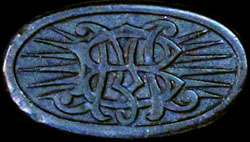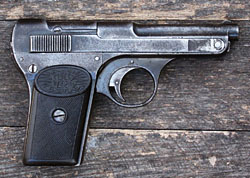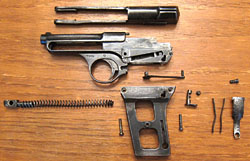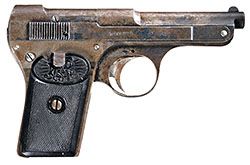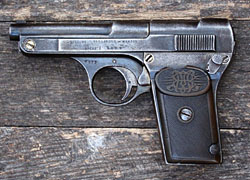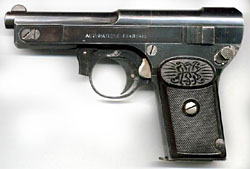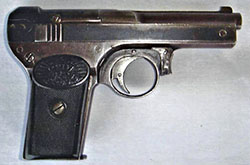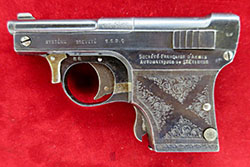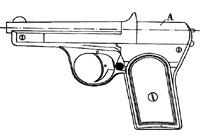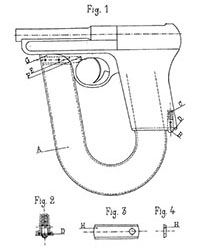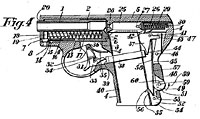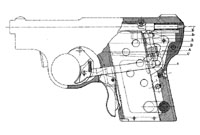|
The Bernardon-Martin Pistol
by Ed Buffaloe
There is little information about the Bernardon-Martin pistol in the English language literature. To his credit, Ian Hogg, in his book Pistols of the World, 2004 edition, provides four
paragraphs about the gun, whereas a number of other English language sources for general information on guns, such as R.K. Wilson, W.H.B. Smith, Edward Ezell, and Geoffrey
Boothroyd, do not mention the gun at all. However, Hogg’s information is incomplete and not entirely accurate.
The situation in French literature was only marginally better until recently. Huon appears to have written his book Les Pistolets Automatiques Francais without a close examination of a Bernardon
-Martin. Daniel Casanova’s article in Gazette des armes seems largely derived from Huon’s book, repeating the same inaccuracies, though it does offer some tidbits of additional information.
The much earlier article by Bernard Meyer consistently misspells the name Bernardon and contains some dubious assertions. However, in 2017 Huon wrote an article on the Bernardon-Martin pistol for the French magazine Cibles, correcting his earlier mistakes; and a new book by
Jean-Pierre Bastié, Les Petites Manufacturers Françaises de Pistolets Automatiques: 1900-1940, has shed some new light on the history of the company.
Thomas Martin is described by Bastié as a gunsmith on the rue Denis-Papin in Saint-Étienne,
France. Étienne Bernardon is described by Huon as an arms manufacturer, also in Saint-Étienne. Martin filed for a patent on a self-loading “automatic” pistol design on 25 November 1905.
French patent number 359992 was granted to him on 9 April 1906. He was also granted Austrian and British patents in 1906 for the same design (see patent information below). The Systeme Bernardon-Martin became the first commercially-produced French auto pistol. The guns were
almost certainly hand assembled, with limited parts interchangeability.
According to Bastié, the Bernardon-Martin company was established in 1906 but was dissolved on 30 December 1907. Judging by serial numbers, this early company may have made less than a
thousand pistols. Martin sold his patents to Bernardon, who became the sole proprietor of the company. Bastié states: “On February 18, 1908, barely two months after acquiring the patents from
Thomas Martin, Étienne Bernardon founded a new limited partnership with shares, the Société Française d'Armes Automatiques, whose head office is located on rue Rolland in Saint-Étienne,
with capitalization of one million francs.” The company did business under the name Bernardon et Cie. Bastié further states that a supervisory board was appointed in May 1908, but that “in October
1908 the company was still looking for an industrial designer.”
I should remind the reader what self-loading pistols were available and might have influenced a French gunsmith in 1905. Existing auto pistols included the 1893 Borchardt, various Bergmann pistols, the 1896 Mauser, the 1900 FN Browning, and the 1900 Mannlicher. The era of Spanish auto
pistol production had not yet begun (or was only just beginning) so no Spanish influence is likely. Charles Clement of Belgium had taken out his first patent in 1903, but his guns
do not appear to have influenced Martin. The 1900 through 1903 Colt pistols were on the market, but could not be sold in Europe. Production of the 1903 FN Browning “le Grand Modèle” didn’t actually begin until 1907.
Hence, of Browning’s guns, Martin probably had seen only the 1900 FN. The FN Browning was the most successful pistol of its day, with wide distribution in Europe, and Martin chambered his
gun for its cartridge, the 7.65mm Browning. However, the design that the Bernardon-Martin most resembles is the 1900 Mannlicher, with its fixed barrel, open-topped slide, and recoil spring
beneath the barrel, though the Bernardon-Martin has a striker, like the Browning, rather than a hammer. Like the Mannlicher, the early Bernardon-Martin had an internal magazine that was
loaded through the open breech. The Bernardon-Martin is an unlocked breech mechanism. I have been unable to detect any influence from other pistols of the era.
The Model 1907 Bernardon-Martin
|
Bernardon-
Martin
Model 1907
Length: 150mm
Barrel: 93mm
Height: 92mm
Weight: 550 g
|
|
In his book Les Pistolets Automatiques Francais, Huon states that: “The grip frame and barrel are machined from a single block of steel.” This is
incorrect, though someone examining the gun only superficially, reading the patent, and examining the patent drawings might make a similar deduction.
In reality, the grip frame and the upper receiver/barrel are separate pieces, each precision machined from separate blocks of steel. Huon also states
that the gun has a cover plate on the left side which provides access to the mechanism. This is an inaccuracy that could only stem from not having the
opportunity to disassemble the gun in person—the two screws that attach the grip frame to the receiver might give the illusion of a side plate if one were unable to remove the grip plate or were
working from photographs or patent drawings. The breech block has two arms that extend forward beneath the barrel, forming a slide. The arms have lugs inside to lock them to the receiver, and
they are flexible so that they can be spread apart and fitted onto the receiver from the rear. At the rear of the breech block on each side is a raised area with 16 triangular-cut serrations to aid in
retracting the slide. A backstrap piece covers two flat springs, one to tension the sear and another to tension the manual safety lever.
My immediate thought when seeing the Bernardon-Martin
for the first time was that I had never seen an automatic pistol with so many screws. Two screws connect the grip frame to the upper receiver. The rear screw
also passes through a hole in the upper portion of the backstrap. Another screw attaches the lower portion of the backstrap to the grip frame from the rear. A screw at the front
of the gun, just beneath the barrel, passes through both arms of the breech block and through a block that retains the recoil spring beneath the barrel. This block has a short recoil spring
guide rod attached to its rear. The manual safety lever is retained by a screw on the right side of the gun, as is the extractor. On the bottom of the breech
block, a tiny screw holds the end-piece that retains the striker and striker spring.
The extractor is a piece of machined steel, curved and with a hook on one end and a hoop of metal at the other end where the screw holds it, tempered into a spring. The firing pin serves as the
ejector. There is a tail on the rear of the striker that serves as a cocking indicator. The only disconnector is a spring-loaded tongue on the back of the trigger that slips past the front crossbar
of the connector when the trigger is fully depressed, allowing the connector to return as the gun cycles. When the trigger is released, the tongue flips up enough to allow it to pass beneath the
crossbar and engage the connector again. Until the trigger is released, it is effectively disconnected from the sear. This mechanism is independent of the position of the slide.
There is a tail on the sear that extends to the rear of the gun. The tail mates with a slot in the bottom of the slide—when the slide is pulled all the way to the rear and the connector bar is
pressed backward (with one’s third hand), the tail catches in this slot and holds the slide open. This was difficult to operate, particularly since it locked the slide at the maximum compression
point of the recoil spring, and it is easy to understand why Bernardon eventually added a better slide hold-open device.
First Variant: The Model 1907 has an internal magazine that must be charged from the top. There is a button at the top of
the right grip plate which serves to release the slide after it is locked open by the rising magazine follower. These guns have 16 triangular-cut slide serrations at the rear of the slide, with a
hole drilled near the lower front corner of the serrations on both sides. This variant has been observed in serial numbers 13, 626, and 1089.*
Second Variant: On the gun featured in this article, which I will refer to as the second variant, the
magazine release button is on the side of the left grip at the bottom rear corner, tensioned by a small flat spring, held in place by the left grip plate. The release button itself is held in the grip
frame by the right grip plate. All future Bernardon-Martin and Bernardon pistols have this type of magazine release. The hole drilled in the slide serrations is eliminated. This variant has been
observed in serial numbers 1019, 1382, and 1961.*
It appears that for a time both first and second variant pistols were made simultaneously, probably in order to use up existing grip frames that had already been machined.
The barrel incorporates a cartridge guide in the form of a small pin projecting just above the chamber, which fits into a hole in the top of the breech block. This cartridge guide is
nearly identical to that of the 1900 FN Browning. The connector bar runs from the trigger, which pivots on a pin, to the sear on the left side of the gun, and is held in place by the
upper portion of the grip frame—the forward portion of the connector projects out from beneath the grip frame and is visible just behind the trigger. The
manual safety locks the sear and hence the trigger, but not the breech. There is a half-round integral front sight and a V- shaped groove at the rear. The magazine on the second and third
variant is of conventional design, with seven holes in either side for viewing the cartridges, and an additional hole on the right side for the latch. It holds seven rounds.
The 1907 Bernardon-Martin is marked on the left side of the slide in all capital sans-serif characters:
SYSTEME BERNARDON - MARTIN
BREVETÉ S.G.D.G.
The right side of the slide is marked:
* L “AUTOMATIQUE FRANÇAIS” *
or later
AUTOMATIQUE FRANÇAIS
The serial number is on the left side of the frame on the bow of the trigger guard. It is also
stamped on the right side of the grip frame, beneath the right grip plate, on the inside of the slide, and on most small parts. The enlarged portion of the barrel, over the chamber, is stamped with the
“BM” monogram in an oval cartouche. The grip plates are of checkered hard rubber with the “BM” monogram in an oval cartouche at the top.
The Model 1909 Bernardon
|
Bernardon
Model 1909
Length: 153mm
Barrel: 94mm
Height: 97
Weight: 618 g
|
|
In 1908 Bernardon incorporated a company which he called Société Francaise d’Armes de St. Étienne, also known as Bernardon et Cie., in which he sold stock in order to raise money.
In 1909 three additions were made to Martin’s original French patent number 359992. These additions were all in the name of Étienne
Bernardon, and were numbered 10491, 10492, and 10493. The patent additions show a redesigned connector and sear mechanism and a grip
safety mounted at the front of the grip. Martin’s name disappears from the gun. After this it is either marked “Automatique Français” or later “Système Bernardon.”*
The major change to the Model of 1909 was that a slide lock lever was added in front of the trigger guard, tensioned by a small spring between the lever and the trigger guard. Two slots were
cut in the bottom of the receiver on either side of the trigger guard bow. When the slide is drawn back while squeezing the locking lever, the lever catches the block that retains the recoil spring
and locks the slide in the open position. This facilitated cleaning the gun. The serrations were eliminated at the rear of the breech block and replaced with steps that increase in height toward the
rear of the gun—these enable the slide to be more easily retracted. The length of the recoil spring guide rod was extended. The shape of the front of the receiver, beneath the barrel, was changed,
making it more squared off, rather than rounded. The cocking indicator was eliminated. The magazine release is tensioned by a coil spring inside the button rather than a flat spring beneath the
grip plate. The Model 1909 is slightly longer and about 2.5 ounces heavier than the previous model.
There are a number of minor variations, the order of which is uncertain. I believe the earliest Model 1909 guns still had a single screw at the front to secure the arms of the breech block
to the the recoil spring guide block. I suspect that problems were encountered with this screw working loose, so a second screw was added, the only purpose of which was to lock the
first screw in place so it would not come loose. Early guns retain the half-round front sight and a simple round barrel, whereas later guns were given a rib on top of the barrel and a
squared-off front sight. The caliber is marked at the rear of the rib on top of the slide: CAL. 7,65.
Guns with the rib have the “BM” monogram stamped laterally over the chamber, rather than longitudinally, or no monogram at all.
In his 2017 article, Huon shows photographs of a Bernardon pistol with an extended grip frame, allowing the gun to have a magazine holding nine cartridges. He does not provide the serial
number. The gun has a single screw at the front of the slide on the left side, and is marked SYSTEM BERNARDON on the left and BREVETÉ S.G.D.G. on the right. It has wooden grip plates. This is the only gun known with the extended grip frame.
One variant of the 1909 Bernardon is marked on the left side of the slide in sans-serif characters:
AUTOMATIQUE FRANÇAIS
The right side of the slide is marked:
SYSTÈME BREVETÉ S.G.D.G.
Later variants of the 1909 Bernardon are marked on the left side of the slide in sans-serif characters:
SYSTÈME BERNARDON
The right side of the slide is marked:
BREVETÉ S.G.D.G.
The serial number is moved to the bottom of the receiver, in front of the trigger guard. Some guns
have the last three digits of the serial number stamped on the bottom of the magazine. The grip plates remain unchanged.
One Model 1909 gun is engraved “ST ETIENNE” on a slight curve above the left grip plate and
“LAPERTOT” above the right grip plate. It was believed this gun was retailed by a local gunsmith in St. Etienne known as Lapertot. However, Bastié is of the opinion that this gun was
instead presented to Pierre Lapertot, an engineer and race car driver who marketed automobiles under the brand Auto-Loire.
The Hermetic
According to Casanova, Bernardon had sunk all his cash into the enterprise, but his production was so low that he was unable to get any of the large distributors, such as Manufrance,
to carry his gun. The Bernardon pistols were more expensive than the Browning and so had difficulty competing. Étienne Bernardon apparently closed his business and liquidated his
machinery, tools, offices, remaining stock, and parts in 1911. The purchaser remains unknown as this time. Whoever bought the parts appears to have assembled a number of guns from
them and to have sold them under the brand name “Hermetic.” According to Casanova, the Hermetic guns are all based on the Model 1909. There is one shown in the 1978 edition of Pistols
of the World. It is marked “HERMETIC 7,65 ST. ETIENNE” on the left side of the slide. Another is
shown in Lugs, Volume 2, marked “HERMETIC CAL. 7,65”. The one shown here is unmarked except for CAL. 7.65 on the left side of the slide. Hogg says, “the stamping of the word ‘Hermetic’
on the pistols is usually crooked, and does not match, either in style or execution, the remainder of
the inscription.” The guns have the same grips as earlier models, with the “BM” monogram. Apparently the left-over parts were mixed, because Casanova states that some Hermetic pistols
have a single screw at the front of the slide, while others have two. The one reproduced in Hogg & Weeks has a single screw, as has the one in Lugs. The front of the slide on the Hermetic pistols I
have documented is squared off rather than rounded.
Production Numbers
Determining how many of the Bernardon-Martin and Bernardon pistols were made is difficult, due to their scarcity.* The Model 1907 Bernardon-Martin depicted here has serial number 1382. The
Model 1909 Bernardon depicted here bears serial number 2381. Most photographs of the Model 1909 and the Hermetic do not show the serial number because it is on the bottom of the receiver,
but the Hermetic shown here has serial number 88, indicating that the Hermetic pistols had their own serial number range. The highest serial number I have recorded for a Bernardon pistol is 3733.
6.35mm Bernardon
I have located photographs of at least one 6.35mm Bernardon pistol, which appears nearly identical with the patent drawing
for Bernardon’s 10491 addendum to Martin’s original patent. The chamber portion of the barrel is marked on the left side CAL.6.35. The left side of the frame, above the grip, is marked SOCIÉTÉ FRANCAISE D’ARMES DE ST ETIENNE. The right side
of the slide is marked AUTOMATIQUE FRANCAIS. The gun has a grip safety on the front of the grip
and also features the slide lock on front of the trigger guard. This same gun is illustrated in Matthews’ Firearms Identification, Vol. 2, on page 47, listed as an “Automatique Francais” pistol
, which is how it is marked.
* Please write to me if you have a Bernardon-Martin, a Bernardon, or a Hermetic pistol. I would greatly appreciate photographs
, descriptions, and serial number information so I can make this article more accurate and informative. I am particularly keen to
obtain detailed photographs of the two early variants of the Model 1907, and also of the Hermetic.
|
The Bernardon-Martin Patents
French Patent 359992 for a “Pistolet Automatique” filed by Thomas Martin, rue Dubois, 3 Saint-Étienne, on 25
November 1905. Essentially the same patent was filed in England on 24 November 1906, titled “Improvements in
Automatic Pistols,” and assigned British patent number 1906-26749. Austrian patent number 29358 became effective in
1907. So far as I can tell the French and British patents are nearly identical. The Austrian patent appears to differ
somewhat, but I am not conversant enough in German to be more specific. The Austrian patent drawing shows the trigger, disconnector, and connector bar mechanisms in greater detail than the other patents.
Martin’s British patent claims four unique features for his pistol: (1) a breech block with
flexible arms that extend toward the front of the gun—what we today would call an open
-top slide, but minus the usual crossbar at the front; (2) a frame with a fixed barrel designed
to accept the breech block and “allowing its reciprocating displacement”; (3) a “push bar”
connecting the trigger and sear; and (4) the sear itself, which was designed with two points,
the front one to engage the striker and the rear one to be engaged by the safety. The
functionality of the disconnector mechanism on the back of the trigger is not explained
beyond its function in activating the connector and sear—possibly because the terminology was lacking.
The French patent states, “La figure 3 représente la carcasse comprenant, en une seule
pièce, le canon et le pontet.” This is rendered in the British patent as: “Figure 3 represents
the framing comprising, in a single piece, the barrel and the trigger guard.” Huon says in
his book, "La carcasse-poignée et le canon sont usinés dans un seul bloc d'acier." This
translates as "The grip-frame and barrel are machined from a single block of steel."
Unfortunately, Huon’s statement isn’t true, as the Bernardon-Martin is the only automatic
pistol I have ever seen where the grip is actually a separate piece from the rest of the frame, but it is possible that Huon was basing his statement on the patent.
French Patent 364506 for a “Magasin chargeur à siphon de
pistolet à répétition” filed by Étienne Bernardon and Thomas Martin on 23 March 1906. Huon describes the invention as a
large capacity magazine that is curved in the shape of a horseshoe, similar to the one which appeared in 1930 for the
Union pistol which was also manufactured in Saint-Étienne. The French patent for the Union pistol magazine (number
693501) does not mention the Bernardon-Martin patent. The two magazines are nearly identical, differing primarily in the
means of attachment to the pistol. I have been unable to find any evidence that this high-capacity magazine was ever
commercially produced, though perhaps some prototypes were made. The 2012 Standard Catalog of Firearms says that you can add 50% to the
value of a Bernardon-Martin that has the high-capacity magazine. My thought is that if you
were to actually locate a Bernardon-Martin horseshoe magazine it could easily be worth more than the gun due to its extreme rarity.
French Patent 386646 for a “Pistolet Automatique” filed by
Thomas Martin, rue Denis-Papin, 24, Saint-Étienne (Loire), on 29 January 1908. British and U.S. patents were also
obtained in 1909 (British patent number 1909-1954 and U.S. patent number 935672). The patent describes a gun with a
barrel that is dovetailed into the frame and held in place with a locking lever and with a grip safety on the rear of the grip. By this time the 1906 FN Browning, with its grip safety, was available on the European
market, and Martin was clearly aware of it. A few prototypes of this pistol survive in Europe, one of which is pictured in Bastié’s book.
Additions 10491, 10492, and 10493 to French Patent 359992 for a “Pistolet
Automatique” filed by Étienne Bernardon, rue Rolland, Saint-Étienne (Loire), on 18
February 1909. Bernardon had purchased Martin’s patents in late 1907. The additions
comprise improvements to the connector and sear, and a grip safety on the front of the grip.
Only the second patent, number 10492, shows a gun that looks like the 7.65mm Bernardon-Martin.
The 2012 Standard Catalog of Firearms says that the second model of the Bernardon-Martin is like the first model with
the addition of a grip safety. Hogg and Huon both state that the grip safety was never implemented. The drawings in the
first and third patent additions both show the bare outline of something on the front of the trigger guard that might be a
slide lock lever, but it receives no mention in the text of the patent. Additionally, the size of the gun in the drawings leads
one to believe the drawings were intended for a 6.35mm pistol and, indeed, the only pistol
we have documented with the front-mounted grip safety is in this caliber.
No further patents were located for Thomas Martin. No further patents were located for
Bernardon related to firearms, though he did patent a method of fabricating pedals for bicycles as late as 1930.
|
|
|
|

